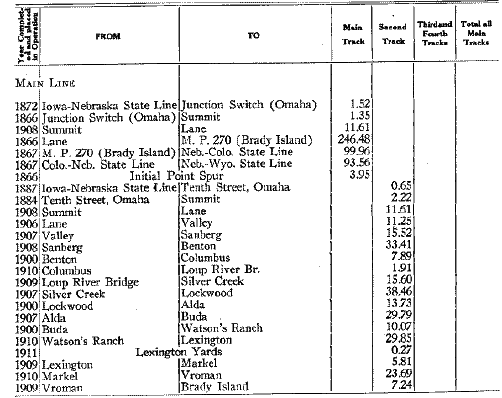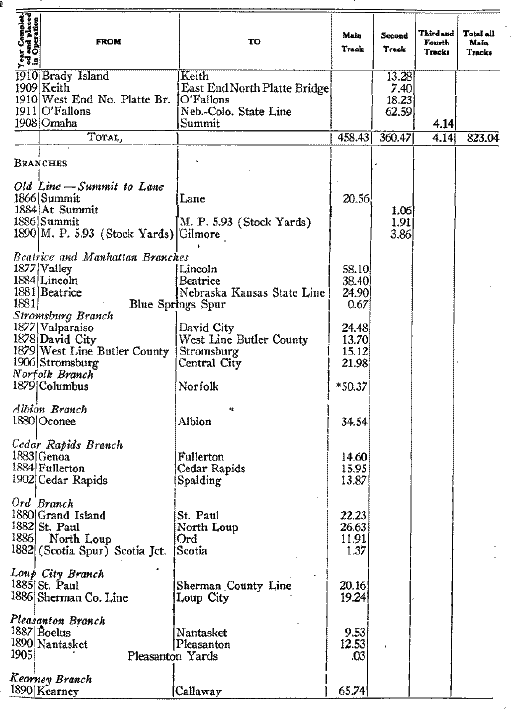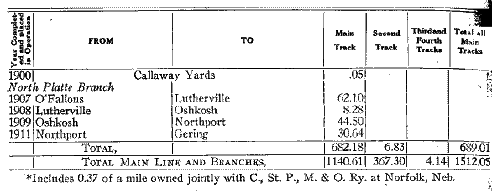curities of the Chicago, Fort Madison & Des Moines
railroad and took possession of the road on November 1,
1899. The road is from Fort Madison to Des Moines, Iowa, 71
miles.
In 1900 branches and extensions were
built: Alliance, Nebraska, to Guernsey, Wyoming, opened June
11, 131 miles; Northport, Nebraska, to Brush, Colorado,
opened September 16, 113 miles; Hill City to Keystone, South
Dakota, opened February 25, 9 miles. About twenty miles of
this is leased from and used jointly with the Union
Pacific.
In 1906 a line was built from Ashton to
Laketon or South Sioux City (107 miles), and in 1907 the
line from Laketon to O'Neill, Nebraska (sic), was
purchased.
In 1909 a branch, 7 miles long, was built
from Lincoln to Cobb Junction, Nebraska.
The Chicago & Northwestern
Lines. The Sioux City & Pacific railroad company was
organized August 1, 1864, in Iowa. The Northern Nebraska Air
Line was organized June 7, 1867. The Sioux City &
Pacific acquired the Northern Nebraska Air Line by
consolidation September 15, 1868. It was built from
California Junction, in Iowa, to the Missouri river and from
the Missouri river near Blair, Nebraska, to Fremont,
completed in February, 1869. Its Iowa organization received
a small grant of lands through act of Congress, of July,
1864. It maintained a steamboat ferry at Blair in summer,
and generally, in extreme cold weather, a track on the ice
across the Missouri river in winter, to the time of the
completion of the present Missouri Valley & Blair
railway and bridge, August 9, 1882.
The Fremont, Elkhorn & Missouri Valley
railway company was organized January 20, 1869. This company
never had any land grant. It commenced construction at
Fremont, after the completion of the Sioux City &
Pacific to that point in 1869. It was extended in that year
to Maple Creek, Nebraska, ten miles north of Fremont. In
1870 it wag completed to West Point and in 1871 to Wisner,
and there rested till 1879, when it was extended fifty-eight
miles to Oakdale, and in 1880 to Neligh; also from Norfolk
junction to Plainview. In 1881 the branch was ex-tended from
Plainview to Creighton, ten miles, and the main line in the
same year was extended from Neligh to Long Pine, about
ninety-eight miles.
In 1882 it was further extended from Long
Pine to Thacher, fifty miles, and again in 1883 from Thacher
to Valentine, six miles. The line to the military post of
Niobrara, three and one-half miles north of Valentine, was
constructed and occupied in the fall and winter of
1880-1881.
At Valentine the Fremont, Elkhorn &
Missouri Valley railroad rested till 1885, during which
time, or before it commenced building again, the road was
sold to the Chicago & Northwestern railway company, and
its future extensions were under the direction and ownership
of that corporation. In 1885 it was extended to Chadron, and
from Chadron to Buffalo Gap, South Dakota; in 1886 from
Buffalo Gap to Rapid City, South Dakota. In September, 1886,
another branch was completed and opened from Fremont to
Wahoo, and on October 25, 1886, the same branch was
completed and opened to Lincoln.
Another line was completed and opened
December 6, 1886, from Scribner to Lindsay. The next year,
1887, this line was extended through Boone, Stanton, and
Madison counties, to Oakdale, the then county seat of
Antelope county. There it intersected and connected with the
main line. That line was completed June 13, 1887. November
21, 1887, the Black Hills line was completed and opened from
Rapid City to Whitewood, South Dakota. In the same year,
December 18, 1887, another line, having been constructed,
was opened from Arlington to Irvington and to South Omaha,
also to a junction with the C., St. P., M. & 0. railway
into Omaha. The same year another line was built from the
Fremont-Lincoln line on the west side of the Platte river to
Linwood and extended from Linwood to Geneva. In 1888 this
line was extended from Geneva to Superior and the Kansas
state line. It was opened September 6, 1888. In 1888 the
branch now known as the "Niobrara line" was extended from
Creigh-
|






